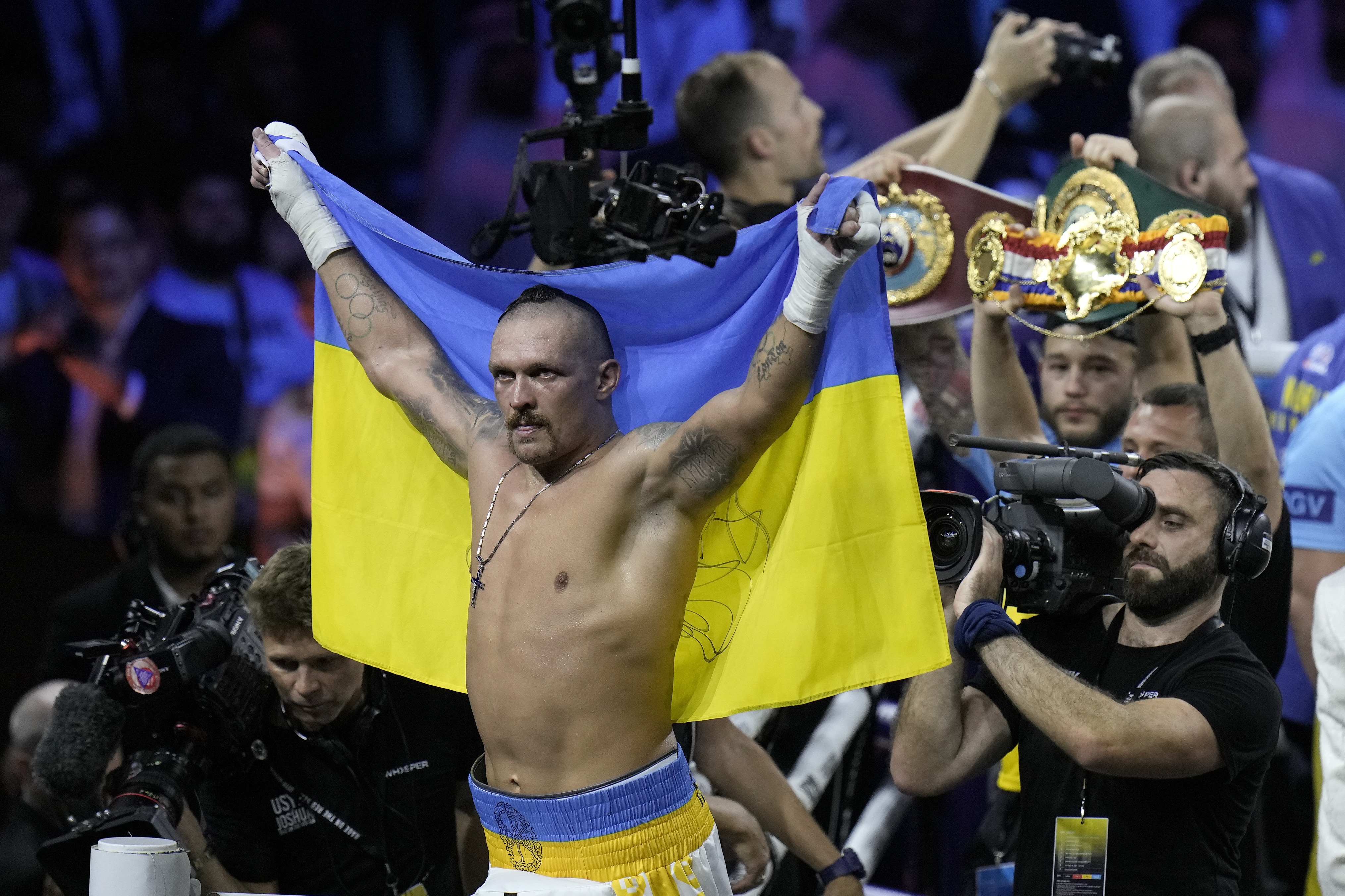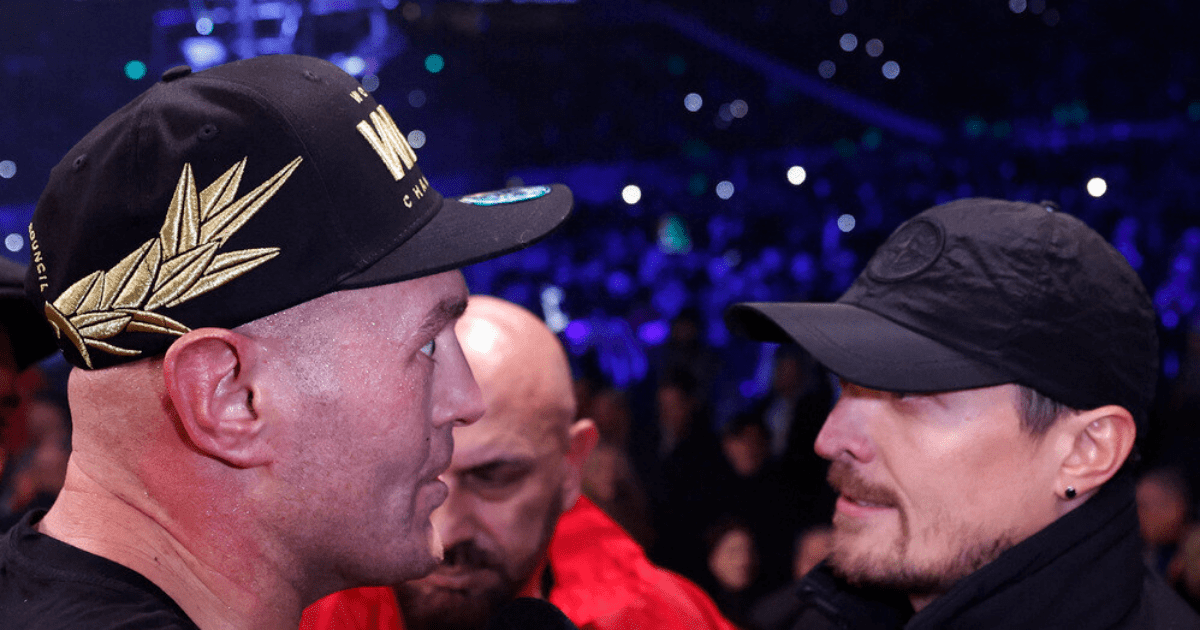OLEKSANDR USYK’s purse for his axed fight with Tyson Fury has been revealed.
The undefeated Ukranian was due to throw down with the Gypsy King in a historic undisputed heavyweight title fight – the first in nearly 25 years – on April 29.
Oleksandr Usyk’s showdown with Tyson Fury collapsed earlier this month
The Ukrainian was set to make a cool £15million for the historic undisputed bout

Usyk is now in talks to face Brit Daniel Dubois
But Team Usyk pulled the plug on the bout after being given the run around by the WBC heavyweight champion and giving into his outrageous 70-30 purse split demand.
And Fury co-promoter Bob Arum has revealed the former undisputed cruiserweight king was in line to take home a cool £15million for the Wembley war.
He told Steve Kim: “If Usyk was in London, he was pretty well guaranteed between £12m-£15m (close to being $20M).”
Fury vs Usyk was originally due to take place in Saudi Arabia, with both fighters set to receive a 50-50 split of the lucrative purse.
And according to Arum, both men stood to make a whopping £48m for the desert dust-up.
He continued: “But he [Usyk] had talked previously to the Saudis who were interested in doing this fight but not until the winter.
“They had apparently agreed to pay him $60m.”
Usyk, 36, is now in talks to face Brit Daniel Dubois – the mandatory challenger for his WBA heavyweight crown.
CASINO SPECIAL – BEST ONLINE CASINOS FOR 2023
But Triple D could be offered a step-aside deal in order for Usyk to have a summer showdown with Fury.
Fury and Dubois’ promoter Frank Warren told talkSPORT: “If Usyk remains undefeated then there is a chance to get that done if it goes on in Saudi.
“The other option is – Daniel Dubois is now the official mandatory – if there was a step aside situation and do the fight in July.”
Usyk and Fury’s failure to finalise their clash was recently slammed by Anthony Joshua – who returns to the ring on Saturday night.

AJ said: “Honestly, I just can’t believe that no fights have been made at championship level.
“But I’m just so happy that I can get back to work and get on with my job.
“I’m looking forward to this assignment and I can’t wait.
“Honestly, I’m really looking forward to it.”
Frequently Asked Questions
How much weight should you lift while working out?
If you are looking to increase your strength, weight lifting is a must. However, there are certain guidelines you should keep in mind when lifting weights. Don’t do it too often. You should lift heavier weights at least once a week. Third, do each exercise 8 times. Fourth, allow for 2 minutes rest between sets. Fifth, all exercises should be performed without momentum. Focus on form and not speed.
What are the potential benefits of learning to Box?
You should be aware of the following factors if you are interested in learning how to box:
- It builds confidence. Learning to box will give you the courage to face bullies or other people who might try to bully you.
- It is good for your health. Boxing increases muscle mass. Muscle mass is what makes you stronger.
- It teaches you self defense skills. Learning how to fight is the first step to protecting yourself.
- It develops your mental toughness. Mental toughness is vital when facing difficult situations.
- It can give you a feeling of accomplishment. Once you have mastered a technique, you will feel like a true boxer.
- It’s fun! It’s fun!
- It’s cheap. All you need to do is get a pair or boxing gloves.
- It doesn’t take up too much space
What is the maximum number of punches a person can take?
A punch is “a blow delivered from the fist”. Only one punch can be sustained by a human. When someone hits you in the face, he/she is punching you. You cannot hit the person back. That would mean two punches.So, technically speaking, humans can only take one punch at a time!
Can I box without fighting?
Boxing can only be learned if you are willing to fight. It takes hard work to improve your boxing technique. However, if you are willing to put in the effort, you’ll be able improve your boxing technique as well as speed, endurance, strength, stamina, and speed.
Watching good boxers fight is the first step to improving your boxing technique. Pay attention to how they move and throw punches. Also, observe how they defend themselves. Try to imitate their movements.
Next, you’ll have to spar against another opponent boxer. This is where you’ll see whether you’ve improved your boxing technique. It’s important to observe how fast you can punch, the strength of your punches and how well you block any incoming punches while sparring.
Finally, you’ll need to practice your boxing skills by doing drills. You will improve with practice so be patient and persevering.
How do you train boxers for beginners?
Although boxing is one of oldest sports, its popularity has increased only recently. Two fighters fight each other in boxing. They punch one another until one falls.
The first step towards becoming a boxer is to find out if you like boxing. You can also watch fights online to see how it feels like hitting someone. After you have decided whether or not you want to be a boxer you will need to decide which type of fighting you prefer.
Statistics
- It is just like normal sparring with a partner, but you want to throw punches at 75% of your normal speed. (wikihow.com)
- This article received 39 testimonials and 89% of readers who voted found it helpful, earning it our reader-approved status. (wikihow.com)
External Links
expertboxing.com
boxandflow.com
How To
These are the basics of boxing
How to box effectively
Boxing is the most loved sport in the world. Two opponents fight each other to the death. Boxing rules vary from one country or another. There are generally three types of boxing: Amateur, Professional, and Olympic.
Amateur boxing is usually practiced at school, college or university. This type of boxing allows sparring without protection. Amateur boxing matches usually consist of three rounds lasting five minutes each. There are many different styles of amateur boxing including Kickboxing, Muay Thai, Taekwondo, Karate, Judo, Wrestling and others.
Boxing professionals are usually trained in clubs, gyms, or stadiums. They use protective equipment, such as mouthpieces, nose guards, shin protectors, elbow pads knee pads, waist belts and groin protectors. Professional boxing competitions consist of six rounds lasting four minutes each. There are several different styles of professional boxing including Boxing, MMA (Mixed Martial Arts), Kickboxing, Muay Thai, Taekwondo and others.
Olympic boxing takes place at the Olympics. International standards dictate that boxers must wear protective gear. The competition lasts for eight rounds, each lasting three minutes. Olympic boxing has only two styles, Light Flyweight vs Heavyweight.
The basics of boxing are:
- Punching techniques
- Guarding techniques
- Footwork
- Stance
- Move your body
- Defense
- Combination
- Rotation
- Sparring
Punching Techniques
There are seven types. Each punch is unique. Some punches are more powerful than others. For example, an uppercut requires great force. A straight punch on the other side requires less power, but is more effective than other punches.
There are many combinations that can be used to punch. These are combinations of punches that work together to achieve a specific goal. One combination can have many parts. An example of this is a left hook, followed by a right crossing. This will damage the opponent’s jaw.
Guard Techniques
A boxer uses his body to protect himself against attacks. He does this by using his legs.
Legs
Boxers should use their legs to defend against kicks. He raises his leg when he is hit with a kick and then moves away from the opponent. If the attack comes from the front, then he bends his knees to avoid being kicked on the side. If the attack is from the side, he will bend his knees to avoid being kicked on the side.
Elbows
Because they inflict pain, elbow strikes can be very effective. You can deliver an elbow strike directly or indirectly. Directly means that you hit your opponent with your forearm while indirectly means that you hit him with another part of your arm.
Hands
Boxers use their arms to stop incoming blows. To do this, they raise their fists higher than their heads and move their arms in the direction that the attack is coming. The attacker’s fist is then in their face.
Knees
To absorb the impact of a punch to the stomach, abdomen, or chest, boxers should bend their knees. Knee strikes are often used for defense purposes.
Feet
Boxers should respond to being attacked by their opponent by standing back and delivering counter-attacks. He can then gain distance from his opponent. In addition, when delivering a counter-attack, a boxer should keep his balance.
Stances
Boxing is only possible if a boxer has a clear stance. His stance determines how he defends himself. It is how he positions himself and where he faces the opponent. Boxers can take many different stances. These are some of our most favorite:
- Low stance
- High stance
- Southpaw stance
- Western stance
Move your body
A boxer must change his position, speed and rhythm in order to win the fight. This requires changing your position, speed, and rhythm.
Rotation
Boxers rotate their arms when they throw a punch. Depending on the type and size of punch, the speed at which the rotation takes place varies.
Combinations
The timing of each individual punch affects the effectiveness or failure of a combination. A combination is good if it starts with a strong punch then ends with a weaker one.
Spare parts
Sparring is a form of boxing that aims to improve your skills. A sparring session is where a boxer trains both his mind and his body. The goal of sparring is to learn to fight, and not to get hurt.
You need to have patience and dedication in order to learn how boxing works. Boxing is a sport that requires dedication and perseverance.

